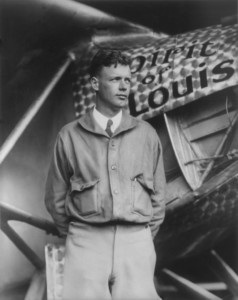Everyone Wanted to Be Charles Lindbergh (Including Mickey Mouse)
By on May 15th 2017
How one man's journey changed the world.
 Charles Lindbergh made his historic transatlantic flight in May of 1927. The feat, which took 33.5 hours, was the first time anyone flew nonstop across the Atlantic Ocean.
Charles Lindbergh made his historic transatlantic flight in May of 1927. The feat, which took 33.5 hours, was the first time anyone flew nonstop across the Atlantic Ocean.
When he succeeded in flying from New York to Paris, Lindbergh was greeted by a groundbreaking (and well-deserved) level of fame. From a largely unknown U.S. Air Mail pilot to a prize-winning, Medal-of-Honor decorated hero, Lindbergh's achievements directly influenced the course of aviation.
But he did more than just influence one industry. His epochal feat left an influential mark on American culture at large.
Lindbergh's flight aboard the
Spirit of St. Louis earned him a number of accolades, including the Distinguished Flying Cross and Congressional Medal of Honor. He was also awarded Time magazine's first ever -Man of the Year.-
Once everybody knew who Charles Lindbergh was, everyone wanted to be him.
They wanted that notoriety, that honor, and that fame.
In the 1920s, aviation was still new and in the making. Many people believed that traveling by airplane was too dangerous. Air travel was rare, and those who flew mostly transported either mail or workers and supplies to mining and oil sites. Stunt flying (performed by ex-fighter pilots from the Great War) became popular before large planes intended for passenger travel.
It wasn't until the latter half of the decade where perceptions began to shift.
Lindbergh certainly contributed to the increased interest in both air mail and commercial aviation. In the years that followed the record-setting transatlantic flight, many other pilots and aviation enthusiasts sought similar fame.
Hawaii pineapple magnate James D. Dole, for example, decided to put up prize money for a transpacific air race from Oakland, California to Honolulu, Hawaii. The
Dole Derby, as it was called, didn't end with the kind of infamy everyone hoped for, however. The August 17, 1927, flight was an ill-fated air race that ended with accidents, disappearances, and death.
Lindbergh also influenced the Transatlantic flight of
The American Nurse on September 13, 1932. Dr. Leon M. Pisculli, William Ulbrich, Edna Newcomer, and a woodchuck named Tailwind departed New York City for Rome in a 1931 Bellanca Skyrocket J-400 Long Distance Special. The plane and all its inhabitants disappeared somewhere over the Atlantic.
Tailwind the Woodchuck wasn't the only rodent with a connection to Lindbergh. A two-dimensional, black and white mouse got his start trying to imitate the American Pilot. You might have heard of him: Mickey Mouse.
Plane Crazy
On May 15, 1928, a small number of individuals watched a test screening of a silent film starring a brand new animated character, Mickey Mouse. In the short film, Mickey is trying to fly a plane in imitation of Charles Lindbergh. Impressively, he builds his own aircraft, does a flight simulation, but when it comes time for the actual flight, it fails and the plane is destroyed. Undeterred, Mickey builds a new plane out of a roadster and parts from the previous plane. He asks Minnie to join him (hey, Lindbergh's flying got him all kinds of fame and attention), but Minnie absolutely wants nothing to do with his loose, wandering lips.
Initially, audiences, much like Minnie, weren't impressed and the cartoon failed to pick up a film distributor.
On November 18, 1928, Disney released a different Mickey Mouse Cartoon.
Steamboat Willie was Mickey's first sound cartoon, and it was an immediate success. Following Steamboat Willie's success, Plane Crazy was re-released as a sound cartoon on March 17, 1929. Though it was the first Mickey film made, it was the fourth to be released. The Gallopin' Gaucho and The Barn Dance were both released in 1928.
Today, it's easy to see that both Charles Lindbergh and Mickey Mouse shaped not only their own industries (aviation and animation) but also the global culture at large. Without Lindbergh's flight across the Atlantic Ocean, it might have taken us longer to get where we are today.
His notoriety from that one flight helped propel him further into success. He helped developed cruise control techniques in American fighter planes as well as the development of a watch designed to help pilots with navigation. That watch is still produced today. Lindbergh also played an instrumental role in designing the
Boeing 747 jet.
Mickey's continued success speaks for itself--for an animated mouse, he's not doing half bad.
Sources:
https://en.wikipedia.org/wiki/Plane_Crazy
https://en.wikipedia.org/wiki/Mickey_Mouse#Debut_.281928.29
https://en.wikipedia.org/wiki/Charles_Lindbergh







